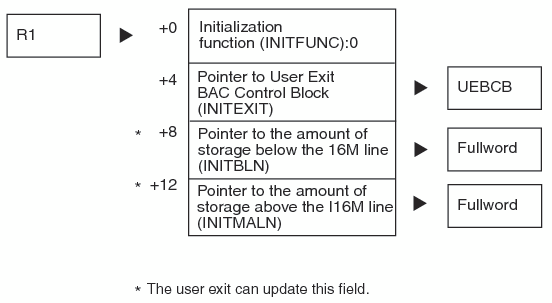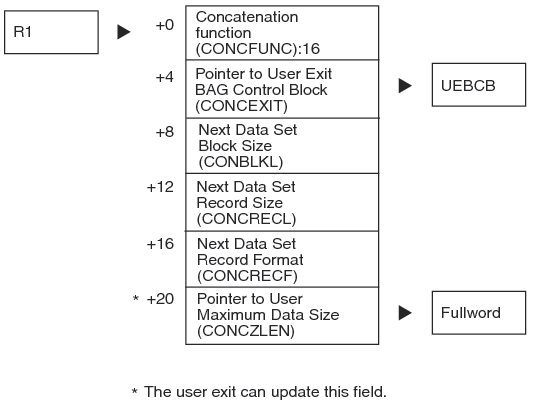Function Descriptions
Initialization Function
SAS calls the Initialization function
before it calls any of the other functions. In the Initialization
function, you specify the amount of virtual memory that your routine
needs above and below the 16-megabyte address line. You store the
length of the work area that you need above the line in the fullword
that is pointed to by the INITMALN field of the Initialization FRCB.
You store the length of the work area that you need below the line
in the fullword that is pointed to by the INITMBLN field of the Initialization
FRCB. All pointers in the Initialization FRCB point to valid data
areas.
In the amount of storage
that you request, you should include space for a Local Register Save
Area (LRSA) of 72 bytes. You must also include any other work areas
that your Parse Options function and Open function needs.
SAS allocates the memory
that you request when it returns from this function, and it stores
pointers to the allocated memory in the UEBCB. The pointer to the
memory that was allocated above the line is stored in the MEMABV field
of the UEBCB. The pointer to the memory that was allocated below
the line is stored in the MEMBEL field.
Parse Options Function
In
the Parse Options function, you validate both the name of the user
exit and any INFILE or FILE statement options that SAS does not recognize.
SAS calls this function once to process the user exit module name.
SAS then calls the function for each statement option that it does
not recognize so that the function can process each option and value
string.
The following figure
illustrates the Parse Options FRCB structure and its relationship
to other control blocks:
Parse Options FRCB
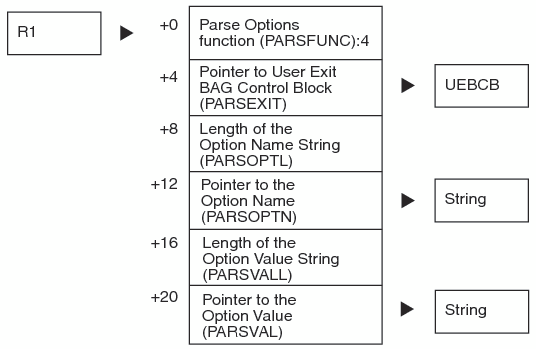
When the Parse Options
function receives control, PARSOPTL is set to the length of the option
name, and the address of the option name is stored in PARSOPTN. For
options that take a value, PARSVALL is set to the length of the value,
and the address of the option value is stored in PARSVAL. For options
that do not take a value, both PARSVALL and PARSVAL are set to 0.
Open Function
SAS invokes the Open function after
INFILE or FILE statement processing opens the associated data set.
The following figure illustrates the Open FRCB and its relationship
to other control blocks:
Open FRCB
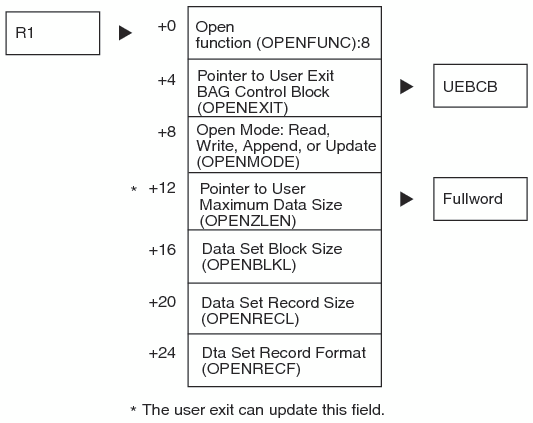
When this function receives
control, the Pointer to User Maximum Data Size field (OPENZLEN) points
to a fullword that contains the Data Set Record Size. In this function,
set the pointer so that it points to a fullword that you initialize.
The fullword should contain the size of the largest record that you
expect to process with the Read function. If it contains a lesser
value, then truncated records might be passed to the Read function.
The Open function should
activate any subprocesses or exits and should solicit from them any
virtual storage requirements.
Read Function
SAS invokes the Read function during
execution of the INPUT statement to obtain the next input record.
The following figure illustrates the Read FRCB structure and its
relationship to other control blocks:
Read FRCB
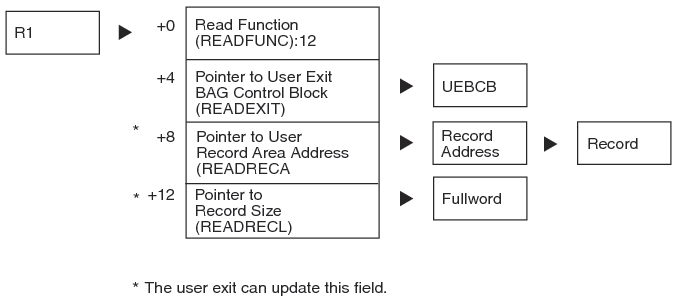
When the Read function
receives control, the READRECA field (or Pointer to User Record Area
Address) points to the address of the current record from the file.
The READRECL field points to a fullword that contains the length
of the record that is in the Record Area.
In this function, you
can change the Record Address so that it points to a record that was
defined by your user exit. If you make this change, then SAS passes
your record to the INPUT statement, rather than passing the record
that was read from the file. However, in this case you must also
update the fullword that the Pointer to Record Size points to: it
must equal the actual size of the record that the Record Address points
to.
Concatenation Function
Write Function
SAS invokes the Write function during
the execution of the PUT statement whenever a new record must be written
to the file. The following figure illustrates the Write FRCB and
its relationship to other control blocks:
Write FRCB
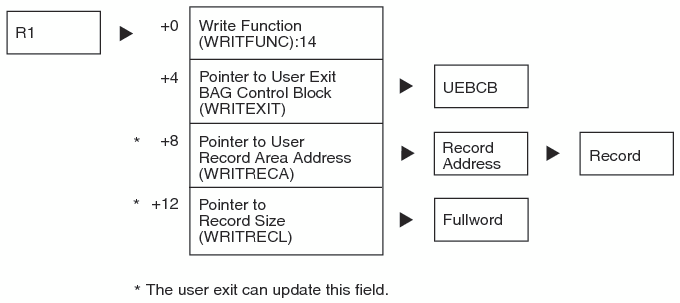
When the Write function
receives control, the WRITRECA field (or Pointer to User Record Area
Address) points to a Record Address. The Record buffer is allocated
by SAS and contains the record that was created by the PUT statement.
In this function, you
can change the Record Address so that it points to a record that is
defined by your user exit. If you make this change, then SAS writes
your record to the file, instead of writing the record that was created
by the PUT statement. However, in this case you must also update
the fullword that the Pointer to Record Size points to: it must equal
the actual size of the record that the Pointer to Record Area points
to.
In the Write function,
you can also change the setting of flags in the UEBCB. As long as
the EX_NEXT bit in the UEBCB is on, SAS calls the Write function to
write the next output record. The DATA step is not prompted for any
new records to output until the EX_NEXT flag has been set. At any
time, if the EX_DEL bit in the UEBCB is on, SAS ignores the current
record, and processing continues to the next record.
